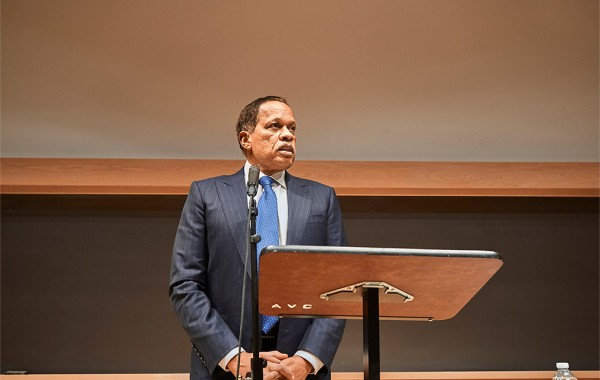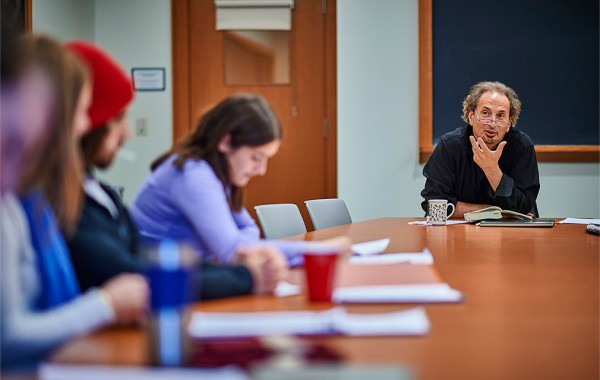Lightening lab costs
Party balloons can no longer be taken for granted: there’s a worldwide shortage of helium. Prices quadrupled between 2000 and 2012, according to the U.S. Government Accountability Office. But a new helium-recovery system will put Colgate’s science laboratories at the forefront of efforts to conserve the dwindling supply of this increasingly expensive gas.
One of the world’s critical and finite raw materials, helium is the second-lightest element and is chemically unreactive. It has a boiling point just 4 degrees above absolute zero, making it ideal for cooling superconducting metals. When those metals are cooled below a critical temperature, their resistance drops to zero. As a result, huge currents can flow through without heat loss. The magnetic fields that result from these currents can be used for research or for medical imaging in MRI machines.
Because of these special properties, physicists and chemists on campus use approximately 2,000 liters of liquid helium annually as a refrigerant to conduct cutting-edge research at low temperatures. During the process, the liquid boils off and escapes into the atmosphere in gaseous form.
“The cylinders are really expensive, and once we use the helium, it is gone,” said Ken Segall, associate professor of physics and chair of the physics and astronomy department.
Segall and his student Matt LeGro ’15 are using helium in studying the behavior of networks of Josephson junctions. Powered by superconducting currents and cooled by helium, Josephson junctions are small electrical circuits that are used for sensing applications, digital processors, and electrical standards. Because they also have a unique pulsing behavior, Segall is studying them to possibly model neuron behaviors in the brain.
“Compared to both traditional computer simulations and biological neural networks, Josephson junction neurons would be orders of magnitude faster,” Segall explained. “This research will be a stepping stone to understanding larger regions of the brain with a wide range of potential applications. For example, in brain-inspired computer learning, processors might be able to complete tasks like group identification and sift through data at a faster rate.”
The new equipment — which includes a liquefier and a recovery system — will collect the evaporated helium gas and condense it back into liquid. The liquid will then be stored in special cylinders and transported back to laboratories for re-use.
Although the full system, located at the dock of the Ho Science Center, costs about $125,000, the savings will be significant. “[It] should pay itself off in five or six years,” Segall said.
— Quanzhi Guo ’18
Kepnes interviews Carter
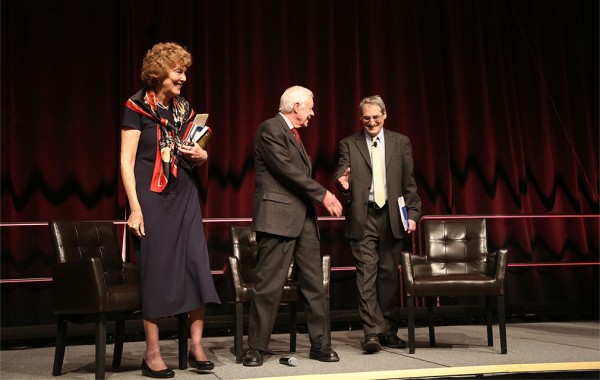
“It was exhilarating,” Steven Kepnes, chair of the religion department and director of
Chapel House, said of interviewing former President Jimmy Carter at the annual meeting
of the American Academy of Religion.
It’s not every day that a Colgate professor gets to interview a former president. Steven Kepnes, chair of the religion department and director of Chapel House, had the opportunity to do just that when he interviewed Jimmy Carter at the annual meeting of the American Academy of Religion on Nov. 24, 2014.
The conference’s theme was climate change, and Carter’s keynote panel — which drew a crowd of more than 5,000 people — focused on the role of religion in climate change and women’s equality.
“Jimmy Carter was one of the first world leaders who recognized the issue of the energy crisis,” explained Kepnes.
Carter began by discussing his latest book, A Call to Action: Women, Religion, Violence, and Power, as well as the role he played in promoting environmentalism during his term as U.S. president. Kepnes and his colleague Mary Evelyn Tucker, senior lecturer and research scholar at Yale University, then posed questions for Carter and delved deeper into the effect that religion may have on these controversial, contemporary topics.
The two interviewers were also interested in the way that Carter had incorporated morality and religion into politics. “He was known for adding a moral dimension to public policy and to foreign policy,” explained Kepnes. “We wanted to ask him how he did that, how he saw that.”
Although it may seem like a daunting task to speak with a former president about such big issues in front of a large audience, Kepnes said that Carter “was a warm guy, he had a good sense of humor, he was down to earth, and we had a wonderful conversation beforehand. It was certainly one of the high points of my academic career.”
Kepnes said the event served “to raise the issue of the environmental crisis — it’s not a future issue, it’s a present issue.” He emphasized that “scholars of religion who are worried about the world, who are worried about ethics, need to take [climate change] into consideration, need to learn about it as every intelligent, educated person should, and [scholars] need to teach about it.”
Kepnes himself gained additional insight into how to address these important issues while teaching his classes, namely the core course Legacies of the Ancient World and Religious Faith and Social Ethics, where religious concepts are discussed in terms of their significance today.
— Meredith Dowling ’17
Tripping the light fantastic
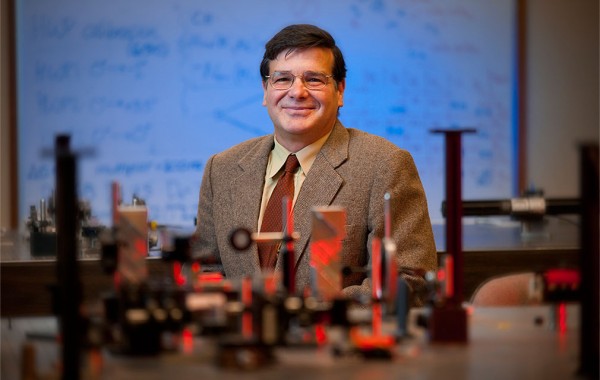
Professor Enrique “Kiko” Galvez, the first to recreate a monstar optical fingerprint in the lab. (Photo by Andrew M. Daddio)
Some people look at the sunlight wandering across the bottom of a swimming pool and see only glare. Kiko Galvez, Charles A. Dana Professor of physics and astronomy, sees the fascinating effect of electromagnetic beams bouncing and sliding through watery matter.
The innate curiosity that leads Galvez to look beyond the obvious has served him well. Last year, for the first time, he and his fellow researchers intentionally created a light pattern known as a “monstar” by polarizing a beam of light and feeding it through a series of carefully placed lenses.
The physics community knew monstars existed. “But no one could figure out how to make them, and it’s one of those things that bugs you,” Galvez said. “I started trying one thing or another, and eventually I figured out the mathematical complexity underlying the pattern — the mathematical structure — so I could convert that to something I could use in the laboratory.”
His work was so revolutionary that it was featured in the Optical Society of America’s (OSA) retrospective on major advances of 2014. Here’s how Galvez described it for publication: “Human fingerprints contain patterns of ridges or lines that converge in loops or stars known as line singularities. Nature also contains ‘fingerprints,’ patterns of line singularities that describe flow and geometry, mathematically revealing topology and representing indefinite quantities.”
Light is a wave. It can flow up and down, side to side, or a combination of the two. Physicists have learned to polarize light — to strip out waves that flow in a horizontal direction, for example, leaving only the vertical waves intact. Galvez faced the challenge of polarizing the wave while controlling its magnitude and phase in a way that would cause the beam to create a particular fingerprint pattern: the ever-elusive monstar.
Galvez and his student researcher, Brett Rojec ’14, worked in tandem. In his spare moments, Galvez thought about the math behind the monstar, trying to envision the algorithm that would describe the light pattern he needed. Once he thought he had the answer, he began to write computer code to process the algorithm.
Rojec set up a table in Galvez’s lab, positioning lasers, lenses, polarizers, polarization-manipulating wave plates, beam splitters, modulators, and a device known as an interferometer at specific points. A beam of light would run the gauntlet and enter a box that would photograph the wave pattern and send the picture into the computer where the newly written program waited to do the analysis.
“By maintaining such exquisite control over the parameters of the light beam,” Galvez wrote for the OSA, “this new type of optical fingerprint can lead to innovative ways to encode and recognize information.”
Manipulating light waves can have a number of practical implications — just think of your favorite polarized sunglasses that keep you from squinting while you drive or windows that protect priceless works of art from UV damage. Think about it hard enough and you, too, might start seeing monstars in your swimming pool.
Props for college-in-prison program
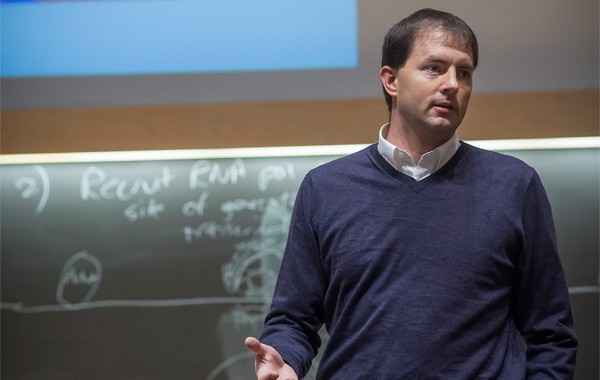
Professor Jason Meyers, pictured here in a Colgate classroom, lends his expertise to teaching a biology course at a local correctional facility. (Photo by Tommy Brown ’79)
A microscope, test tubes, and dissected organs — these aren’t typically found in a prison. But, when Colgate professor Jason Meyers signed on to teach a human biology course at a local correctional facility, these learning materials made their way into a rather unlikely classroom.
The Mohawk Consortium College-in-Prison Program began its three-year pilot program this year, sponsored by Mohawk Valley Community College. Both Colgate and Hamilton College participate in the grant-funded program, which offers college credit–bearing courses to more than 30 inmates in the Mohawk Correctional Facility in Rome, N.Y.
The program, initiated by Hamilton professor Doran Larson (English and creative writing), aims to reduce the number of inmates (65 percent) who finish their sentence and are later incarcerated for other crimes. Post-secondary education has proven to reduce recidivism rates for inmates — between 9 and 13 percent for those who earn two-year associate degrees, according to the program proposal.
When Colgate was invited to join the program, Meyers, a biology and neuroscience professor, jumped at the opportunity. “I was interested in the important service that this would be bringing to an underserved population,” he said.
“One of the things that was challenging, but also incredibly rewarding, was working to design lab exercises that could be done in prison,” said Meyers, “The students were so engaged in these exercises, it was fun to watch how excited they were.”
The experience “opened my eyes to some of the challenges and needs of our criminal justice system, and showed me how much impact education can have on the guys participating,” said Meyers. “I hope that with the continued success of the program we can encourage bigger conversations about the role of colleges in participating in education of inmates.”
This past fall, the program was recognized for its contributions with the Continuing Education Association of New York’s James C. Hall Exemplary Credit Program Award.
— Natalie Sportelli ’15
Fox journalist on race relations
Journalist and Fox News political analyst Juan Williams called the relationship between race and police forces in America one of the most central issues in American life when he spoke on campus in February, in a lecture titled “Are You Baffled? Race and Law Enforcement in America.”
He asked the audience to be open to real dialogue about the modern civil rights movement, a conversation he finds is often divided along racial lines and political expression.
“I understand how the history of black people in America is not simply a dry topic preserved on the pages of a book,” said Williams. “This is a talking book, this is a living book. People are interacting with that history, there is always dialogue with regard to that history, there is always tension with regard to that history.”
A question-and-answer period following the lecture sparked conversations about race in America today and about issues surrounding systematic racial discrimination, opportunities for minority groups, and personal responsibility. Some questions drew a consensus of opinion, including the damaging effects of police militarization on community relations. Others yielded opposing viewpoints, like whether America today offers opportunities for African Americans to break away from historically oppressive structures and pursue the American dream.
“Mr. Williams had some very insightful things to say with regard to the way that time and the past have had an effect on what happens today,” said David (D.J.) Jordan ’17, president of Brothers. “But I have a lapse in understanding how someone like me and someone like him can come from very much the same place…. He believes that [success] is possible for anyone and everyone, when in reality, no, America is not equal opportunity.”
“I think that a lot of different opinions were heard,” said Hannah Loiacono, president of College Republicans, “and that’s what is important.”
— Natalie Sportelli ’15
Balakian on anniversary tour
In honor of the 100th anniversary of the Armenian genocide in Turkey, Professor Peter Balakian has been touring the United States to speak about the atrocities. Colgate’s Donald M. and Constance H. Rebar Professor of the humanities, Balakian is a leading international expert on the subject and a descendant of a genocide survivor. He has moved many people with his heartfelt narration of an almost-forgotten history about the first genocide of the 20th century.
On April 24, 1915, the arrests of 250 cultural leaders in Constantinople/Istanbul set in motion the mass killing of more than a million Armenians in Turkey. The Armenian genocide became the template for genocide in the 20th century.
Balakian has appeared on The Charlie Rose Show and on 60 Minutes with Bob Simon. He is the author of numerous books including The Burning Tigris: The Armenian Genocide and America’s Response. Balakian’s Black Dog of Fate — winner of the 1998 PEN/Martha Albrand Prize for the Art of the Memoir, a New York Times Notable Book, bestseller of New York Times, Los Angeles Times, and Publisher’s Weekly — was recently issued in a 10th-anniversary edition.
At press time, several campus events were being planned for April to observe the anniversary.
Fern find
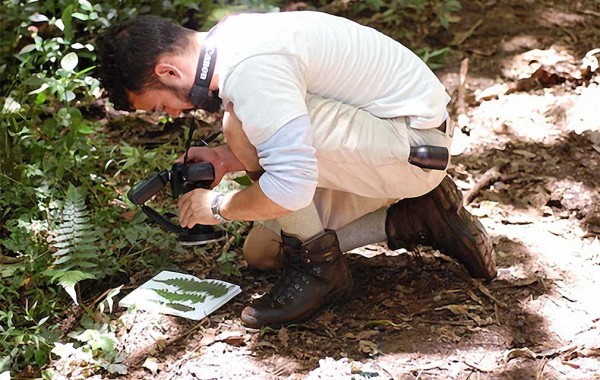
Wes Testo ’12, a student of Professor Eddie Watkins, photographing ferns in Costa Rica. (Photo by Jarmilla Pitterman.)
Professor Eddie Watkins was part of a team of researchers that found a rare new hybrid fern in Costa Rica. “The new fern we discovered is an unusual hybrid between two quite different parental species, and is in fact the only known hybrid in this particular section of the genus,” he explained.
“Hybrids tell you something about the evolutionary history of the two parental species … more distantly related species are less likely to cross. It also tells you something about the reproductive biology of the species,” said Watkins. “In our case, the parents are not closely related, but they can still form a hybrid. This suggests something unusual about reproductive isolating mechanisms in the group.”
Watkins discovered this “huge plant with leaves over one meter wide” along with Rehman Momin ’15,Wes Testo ’12, and Jarmilla Pitterman, a professor at UC Santa Cruz. Their findings were published in Brittonia, a specialized botanical journal managed by the New York Botanical Garden.
The team named the fern Pteris xcaridadiae after Caridad Zúñiga Calvo, the matriarch of a Costa Rican family that owns and protects the area where the fern grows. The place where they made the discovery is one of the most endangered biomes in the world. “The name was perfectly appropriate,” Watkins said, “because neither the fern nor the forest would be there without Caridad and her family.” It is also a fitting name because Caridad translates to charity in English. Watkins quipped, “What is more charitable than saving a rare piece of nature for future generations?”
Admiral Stavridis advocates ‘smart power’
Focusing on the idea of “building bridges rather than walls,” retired Admiral James Stavridis spoke about current challenges to global security and opportunities for international collaboration during his visit to Colgate in February.
As NATO’s former Supreme Allied Commander-Europe, an accomplished member of the Navy, and the current dean of The Fletcher School at Tufts University, Stavridis is a well-known voice in global affairs.
He discussed some of the current hot topics in global security, such as terrorist group ISIS, weapons of mass destruction in Iran and North Korea, tensions in Syria and East Asia, and the fragility of the European economy. He also covered more general topics such as pandemics, cyber crime, poverty, and inequality.
Stavridis pointed to collaboration as the best solution to each of these threats: “These are the bridges: alliances, coalitions, partnerships. We don’t have to do this by ourselves. We [the United States] cannot be, nor should we be, the world’s policemen, but we can be leaders.”
Stavridis advocated for the use of “smart power” as a major opportunity moving forward. This combination of soft power — benevolence enacted to advance a certain set of values — and hard power, such as use of the military, is what he believes will truly make a difference.
“The lecture certainly dispelled any stereotypical images an audience might hold about the militarist orientation of top officers of the armed forces,” said Fred Chernoff, Harvey Picker Professor of international relations and director of the International Relations Program.
— Meredith Dowling ’17
Syllabus
Core 108SA: The Story of Colorants
Core area: Scientific Perspectives
Patricia Jue, lab instructor in chemistry
TR 9:55 a.m., Wynn B31
Course description: Throughout history, humans have employed colors in artistic and creative expression. Some colorants occur naturally. Other colorants are manufactured, and thus the result of scientific and industrial development. In this course, the interplay between artistic expression and science/technological discovery is considered.
Key assignments and activities:
- Field trips to:
- Munson Williams Proctor Arts Institute, Utica
- Colgate Picker Gallery collection
- Golden Artist Colors, Inc. (paint manufacturer)
- Narrative research paper, and poster presentation
- Hands-on exercises with dyes and pigments
On the reading list:
The Chemical History of Color, Mary Virginia Orna
The Brilliant History of Color in Art, Victoria Finlay
Caveman Chemistry: 28 Projects, from the Creation of Fire to the Production of Plastics, Kevin M. Dunn
The professor says:
“Colors are so fundamental that we start asking about them as children: What makes the sky blue? What is a rainbow? How is this crayon ‘burnt sienna’? We look at the physical and chemical properties of colorants, and how their interaction with light obtains the characteristic we describe as color. We consider a variety of colors including those found in the ‘natural world,’ synthetic colorants such as the chrome yellows loved by van Gogh and Perkin’s mauveine (one of the first synthetic dyes), and the richness of metal alloys and patinas.”
Got Happiness?
In an environment rampant with intellectually challenging exams, busy schedules, depressing world news, and the occasional subzero temperature, it can be hard not to let stress and negative thoughts cloud our minds. When this happens, it’s important to take a step back and question: Are we happy?
Several groups on campus have been talking about different approaches to happiness this year.
1. Global“The Scientific Pursuit of Happiness,” “Traditional Roots of Happiness and What Public Policy Can Do to Enhance It,” and “The Myth of Happiness: What Should Make you Happy, but Doesn’t, What Shouldn’t Make you Happy, but Does” were just a few of the discussions sponsored by the Lampert Institute for Civic and Global Affairs, “where intellectual life gets real.” In 2014–2015, the institute’s themed programming shed light on loaded questions about happiness.
2. Spiritual“Does Religion Make People Happier?,” “How are Physical and Emotional Well-being Connected?,” and “What is the Role of Relationships in the Pursuit of a Happy Life?” were some of the Heretics Club lunchtime series talks sponsored by the Office of the Chaplains. They focused on different themes related to happiness, wealth, and the relationships people have with faith.
3. AcademicPsychology professor Rebecca Shiner is teaching a spring 2015 course titled The Good Life: Psych Science. Students explored the nature of human happiness, joy, and pleasure, altruism, material wealth, spiritual practice, and kindness.
— Emma Loftus ’16


